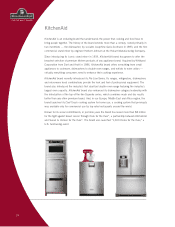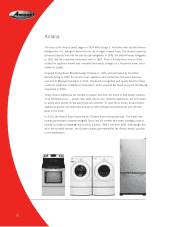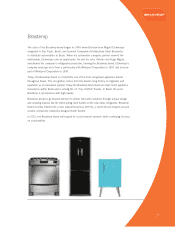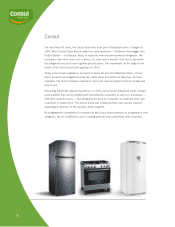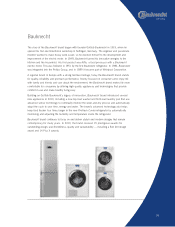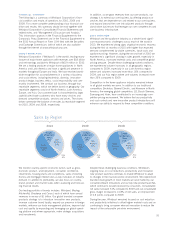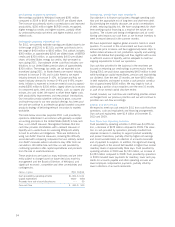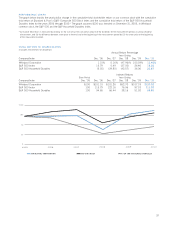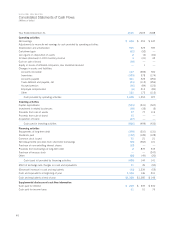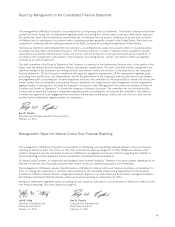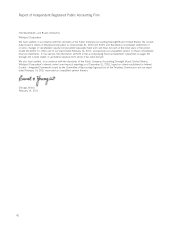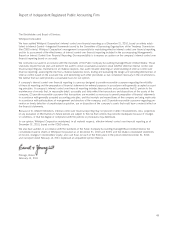Whirlpool 2010 Annual Report Download - page 39
Download and view the complete annual report
Please find page 39 of the 2010 Whirlpool annual report below. You can navigate through the pages in the report by either clicking on the pages listed below, or by using the keyword search tool below to find specific information within the annual report.
34
Net Earnings Available to Whirlpool
Net earnings available to Whirlpool increased $291 million
compared to 2009 to $619 million or $7.97 per diluted share.
The increase was primarily due to cost reductions and improved
productivity, $156 million higher BEFIEX credits recognized,
higher energy tax credits and higher volumes, partially offset
by unfavorable product price/mix and higher material and oil-
related costs.
FO RWARD -LOO KIN G PE RSP EC TIV E
For 2011, we currently estimate earnings per diluted share to be
in the range of $12.00 to $13.00, and free cash flow to be in
the range of $400 million to $500 million. This outlook includes
$200 million, or approximately $2.60 per diluted share, of BEFIEX
credits and $300 million, or approximately $4.00 per diluted
share, of United States energy tax credits, that we expect to
earn during 2011. Our estimate of free cash flow includes con-
tributions to our United States pension plans of approximately
$300 million. The energy tax credits are not expected to be
monetized during 2011. In North America we expect industry
demand to increase 2–3% and in Latin America we expect
industry demand to increase 5–10%. In Europe and Asia we
expect industry demand to increase 2–4% and 6–8%, respec-
tively. Inflation is expected to increase material costs by approxi-
mately $250 million to $300 million, largely driven by increases
in component parts, steel and base metals, such as copper, alu-
minum, zinc and nickel. We expect to offset these higher costs
with productivity improvements and new product introductions.
Our innovation product pipeline continues to grow, consumer
and trade response to our new product offerings has been posi-
tive and we continue to accelerate our global branded consumer
products strategy of delivering relevant innovation to markets
worldwide.
The table below reconciles projected 2011 cash provided by
operations determined in accordance with generally accepted
accounting principles in the United States (GAAP) to free cash
flow, a non-GAAP measure. Management believes that free
cash flow provides stockholders with a relevant measure of
liquidity and a useful basis for assessing Whirlpool’s ability
to fund its activities and obligations. There are limitations to
using non-GAAP financial measures, including the difficulty
associated with comparing companies that use similarly named
non-GAAP measures whose calculations may differ from our
calculations. We define free cash flow as cash provided by
continuing operations after capital expenditures and proceeds
from the sale of assets/businesses.
These projections are based on many estimates and are inher-
ently subject to change based on future decisions made by
management and the Board of Directors of Whirlpool, and
significant economic, competitive and other uncertainties and
contingencies.
(Millions of dollars) 2011 Outlook
Cash provided by operating activities $1,000–$1,100
Capital expenditures (600)– (650)
Proceeds from sale of assets/businesses — – 50
Free cash flow $ 400–$ 500
FIN ANCI AL C ONDITIO N AN D LI QUI DIT Y
Our objective is to finance our business through operating cash
flow and the appropriate mix of long-term and short-term debt.
By diversifying the maturity structure, we avoid concentrations
of debt, reducing liquidity risk. We have varying needs for short-
term working capital financing as a result of the nature of our
business. The volume and timing of refrigeration and air condi-
tioning sales impacts our cash flows as we increase inventory to
meet increased demand in the summer months.
We have experienced negative global economic trends in recent
quarters. To succeed in this environment we have recently
announced price increases and have aggressively taken steps to
further reduce all areas of cost, production capacity and working
capital. We believe that operating cash flow, together with access
to sufficient sources of liquidity, will be adequate to meet our
ongoing requirements to fund our operations.
Our cash flow priorities for the business in the near term are
focused on returning our credit ratings to pre-recession levels.
During 2010, we paid down approximately $400 million in debt
while funding our capital expenditures, pension and maintaining
our dividend. Over the next 15 months, we have $650 million
in debt maturities and expect to make a cash pension contribu-
tion of approximately $300 million. We may begin to look at
addressing a portion of our maturities over the next 15 months
as part of our normal capital structure review.
Overall, however, our cash flow and credit rating priorities remain
unchanged from our previous priorities and we will continue to
prioritize our cash flow accordingly.
Sources and Uses of Cash
We expect to meet our cash needs for 2011 from cash flows from
operations, cash and equivalents and financing arrangements.
Our cash and equivalents were $1.4 billion at December 31,
2010 and 2009.
Cash Flows from Operating Activities
Cash provided by operating activities in 2010 was $1,078 mil-
lion, a decrease of $472 million compared to 2009. The reduc-
tion in cash provided by operations primarily resulted from
required increases in inventory to support product availability
and product transitions, partially offset by higher net earnings
and more favorable terms of collection of accounts receivable
and of payment to suppliers. In addition, the significant slowing
of sales growth in the second half resulted in higher than normal
inventory levels of approximately three days. Cash provided by
operating activities in 2009 was $1,550 million, an increase of
$1,223 million compared to 2008. Cash provided by operations
in 2009 included lower payments for inventory, lower cash pay-
ments for accounts payable and other operating accruals and
lower employee compensation payments, partially offset by
lower collections of accounts receivable.


